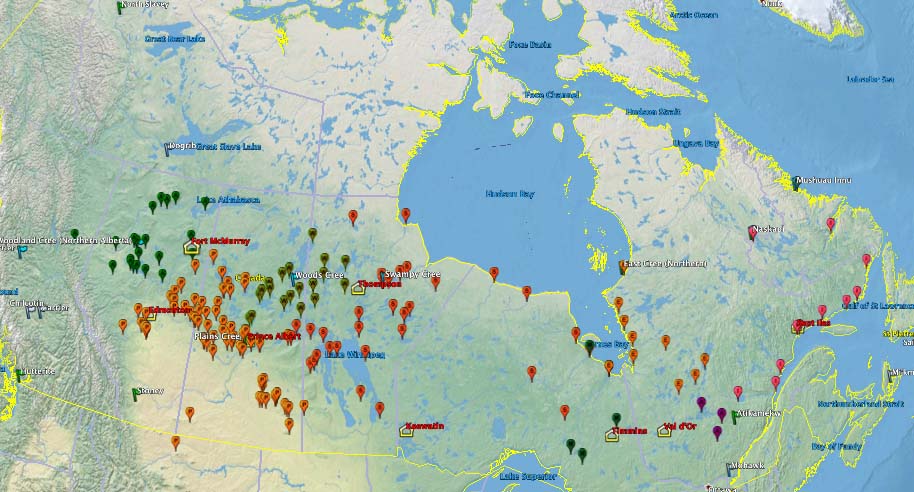Our Dear Partners,
As you are all aware, the Naskapi Bible translation project is just one of dozens of languages across Canada still spoken by First Nations people. Some are so closely related to Naskapi that we understand them and they understand us very well–such as the Mushuau Innu in Natuashish, Labrador or the Northern East Cree at Whapmagoostui on Hudson Bay. Still, there are many other communities across the north part of Canada clear west over to the Rocky Mountains where there are people who speak related dialects that are like each other but less and less like Naskapi.
Some of these languages have had a long history of Bible translation work in them, like Plains Cree, Moose Cree, Montagnais, Atikamekw, Algonquin, and Southern East Cree, with translated New Testaments or whole Bibles in those languages.
Some of these languages have work going on by our contemporaries and colleagues even now, and people who have waited for many years are just hearing the gospel in their own mother tongue for the first time.
Yet still some speakers of these languages are still waiting for translations in their own mother tongue.
 This week, we have an opportunity to meet and discover how God is at work in many of these communities across Canada, and how we might be used to help all of the First Nations language speakers in Canada to have adequate access to God’s Word. Representatives from the Canadian Bible Society, our own field director, and other interested parties will be meeting together with us all day on Thursday at CanIL (the Canadian Institute of Linguistics) here in British Columbia to:
This week, we have an opportunity to meet and discover how God is at work in many of these communities across Canada, and how we might be used to help all of the First Nations language speakers in Canada to have adequate access to God’s Word. Representatives from the Canadian Bible Society, our own field director, and other interested parties will be meeting together with us all day on Thursday at CanIL (the Canadian Institute of Linguistics) here in British Columbia to:
- Pray together
- Share how God has been at work in the existing projects we have all been involved in
- Look at the big picture of how God is at work in all the other language communities in Canada
- Discuss how we may be used by God in our partnerships together with the Bible Society, SIL/Wycliffe, and the First Nations communities that are still waiting for God’s word in their mother tongue, and continue to help the Naskapi with their goals
On Friday, Bill and Norma Jean will be meeting with our field director to pray and discuss our ways we can work to best meet the language development needs of many communities including and beyond Naskapi.
On that same day, Bill and Norma Jean will be celebrating the work that God has done in the Naskapi project with a presentation to the entire staff and student body at CanIL, and challenging them to consider how they might be involved in the work that remains in Canada in the future.
Later that day, we will join our field director meeting with some of the linguistics students who have expressed an interest in First Nations language work in Canada. Maybe God will use some of them to join us in the work.
You can pray with us,
- that we will be sensitive to God’s Holy Spirit as we meet together this week,
- that God will continue to work in the hearts of First Nations communities who we would partner with to do translation work,
- that God would open our eyes so that we can see where the fields are ripe,
- that He might send more workers into His harvest field here among the First Nations languages of Canada that are still waiting to hear the Good News in their heart language.
Serving with you,
Bill and Norma Jean


Our eyes on the world are frequently shaped by the information from the mass media. Looking at this maps drives home the realization that God sees each of these small groups and cares for them. What do the colors and the other symbols mean on the map?
Coloured spots are different language communities according to the Ethnologue, dark green on the left is Northern Alberta Cree, then orange Plains Cree, then green Woods Cree, then red Swampy Cree, then green Moose Cree, then yellow East Cree, then purple Atikamekw, then pink Innu (Montagnais), then blue Naskapi. Other symbols (small flags) are previous and future identified translation needs.